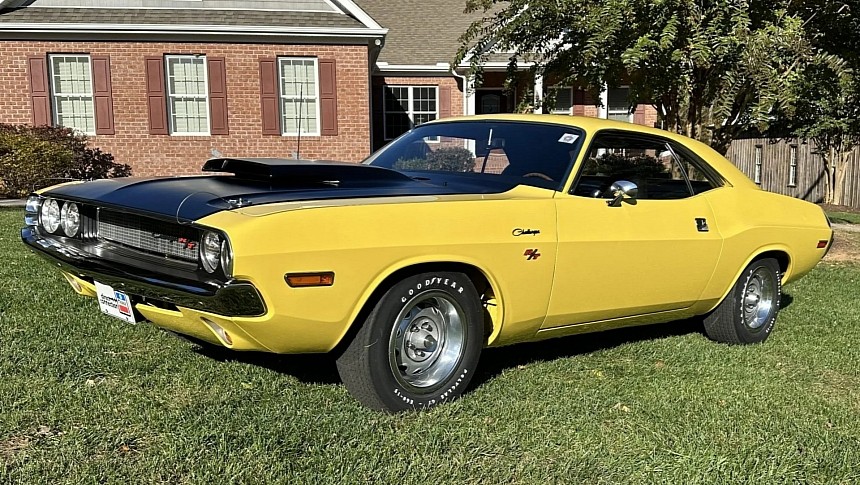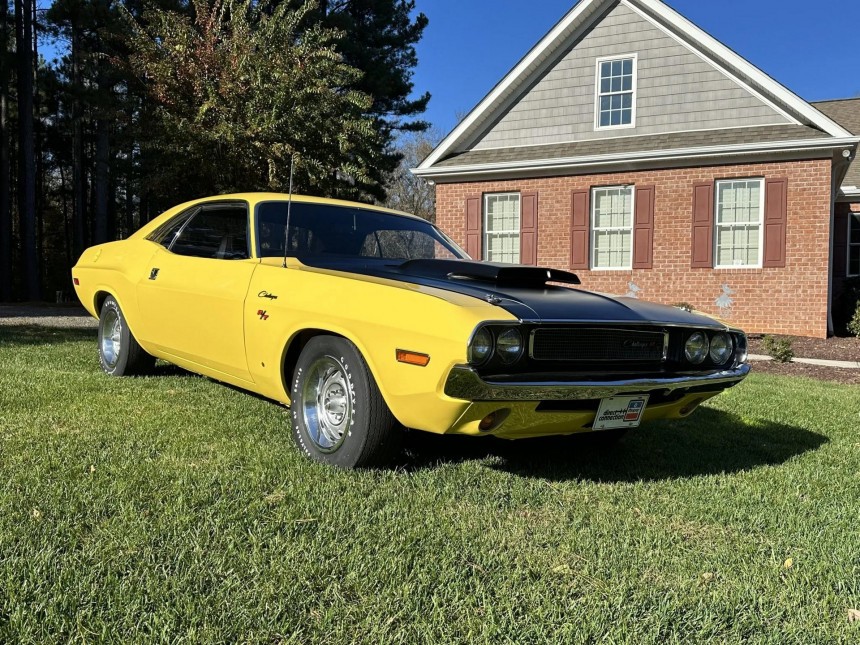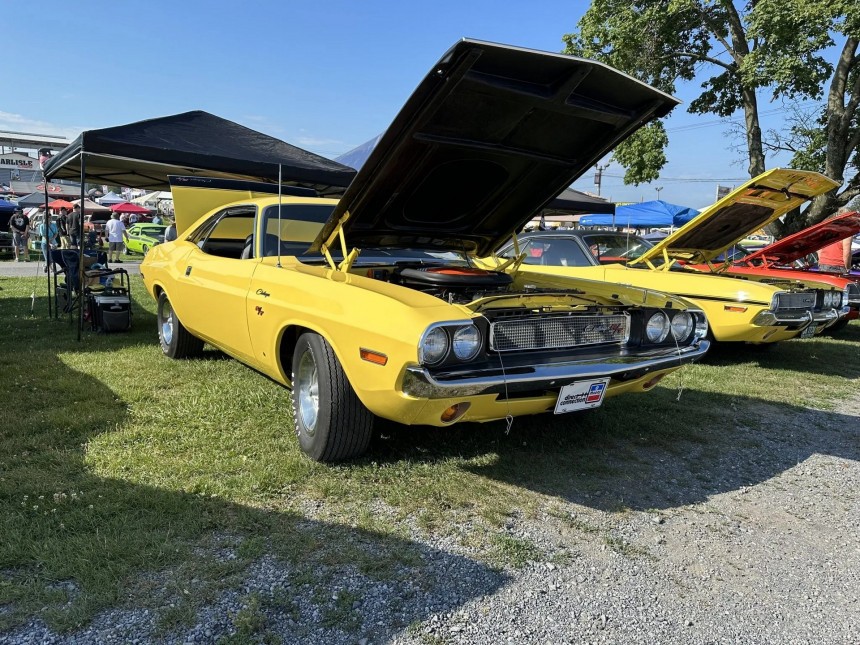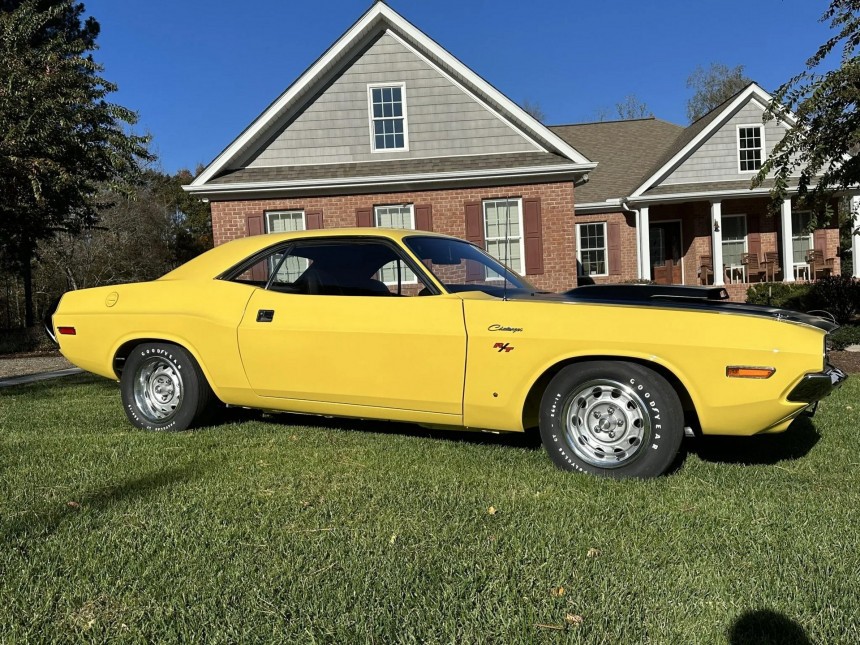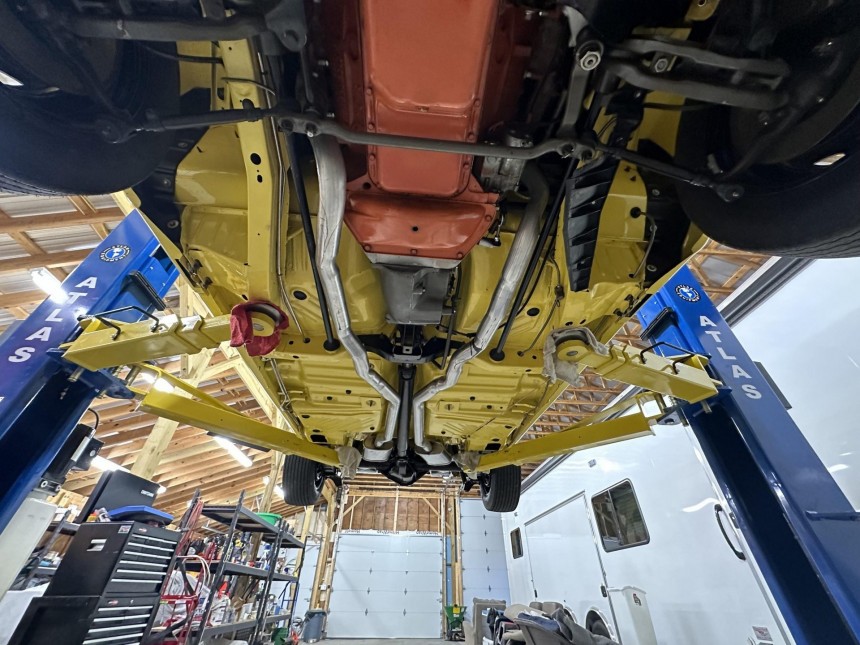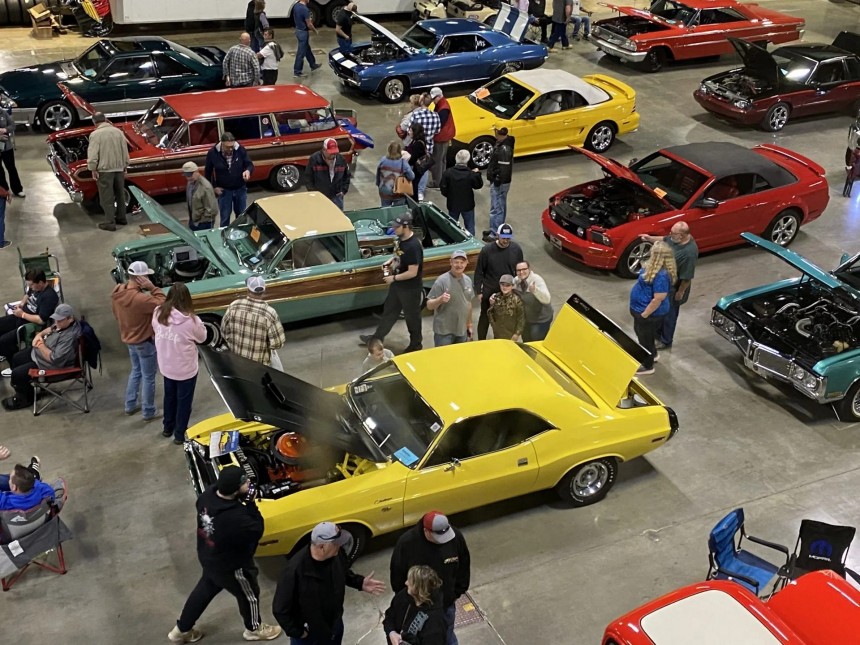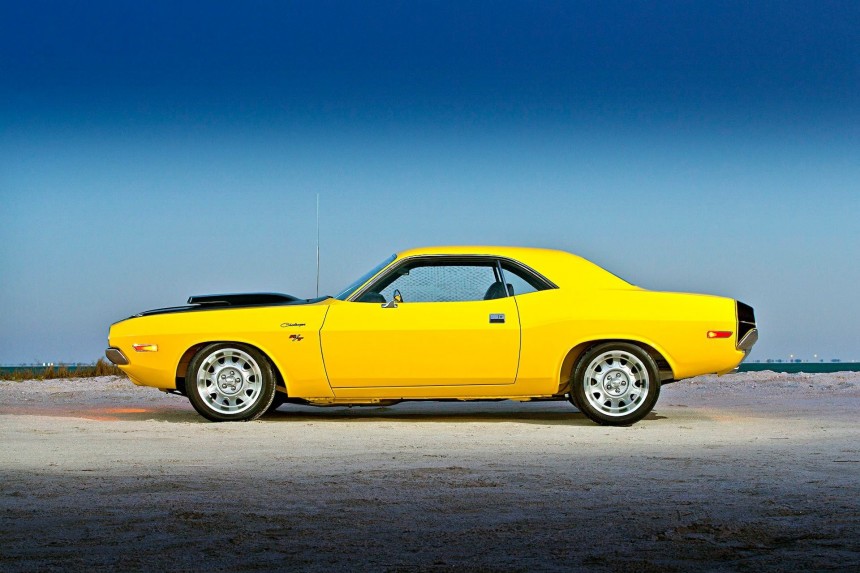Sometimes, patience is the most valuable tool in a gearhead’s vast arsenal of piston wizardry at their disposal, and a particular 1970 Dodge Challenger is solid proof of this theory. A man waited for three decades to buy it – this exact car, not one like it – and nothing could stop him from making it happen. Not even a highly aggressive form of blood cancer; when Mopar runs through your veins, there’s nothing on Planet Piston that can take you down.
Let’s turn back the pages of time and set the calendar to 1976 – a nasty period of American motoring, as far as performance (read ‘tire smokin’ fun’) was concerned. It was when muscle cars of the late sixties and early seventies sold for a dime a dozen. Back then, car guys and gals had lost hope that there would be a time when the metal anarchy would end and the great muscle cars of the great era would become legends.
On one of the 365 days of that year, a certain John Howard was chilling at one of his buddies’ speed shops. Naturally, they were engaged in a discussion regarding – you guessed it – highly philosophical concepts, dissected into quarter-mile arguments on each side. Suddenly, their arduous foray into the bench racing school of thought was cut short by the arrival of a challenger.
Pardon the play of words, but it was a literal and majestic Challenger – capital C intended – bearing the Dodge nameplate on the trunk panel. A real-deal muscle car from 1970 had fallen out of its owner’s grace and was now searching for a new caretaker. Back then, the best social media available was an actual gregarious formation of real people exchanging verbal signals; one good way to find a buyer was to ask around, mainly in places prospects were known to frequent.
John Howard saw the opportunity and asked for a test drive –he got it on the spot. After taking the Mopar for a spin, the two men shook hands, and the buyer got a good deal at less than $3 for a cubic inch of displacement. Unfortunately, in 1976, ATMs weren’t the quasi-ubiquitous commodities we’re familiar with, and the simplest way to get money out of a bank account was a trip to the bank and a nice little chat with the non-automated teller.
Also, in the seventies, $1,200 was quite a considerable sum (roughly $6,500 in 2023 purchasing power equivalent), so the two men agreed to close the deal the following morning. Sadly, as John Howard found out, a handshake and a man’s word aren’t always the ultimate display of incorruptibility, the bad-tasting way. When the eager would-be buyer woke up the morning after agreeing to get the Challenger burden from the seller’s shoulders, a phone call swept him off his feet.
The Dodge proprietor was at the other end of the line, and his message left an impression so strong on the excited John Howard that it would take over thirty years to heal. ‘I sold the car,’ said the man, and you can probably imagine how far down south things went after that line. If you can't, read on as the story now begins.
Not only was the nice 440-cubic-inch (7.2 liters) Challenger in the hands of another driver, but the worst part was this: whoever got the car didn’t wait for too long – less than a month – before taking it apart, piece by piece, with the firm intention of rebuilding the nice R/T from the ground up. That’s right, the coveted Dodge wasn’t just any Challenger, but a four-speed manual with the Six-Pack upfront.
The new owner’s intentions could have paved an interstate to automotive Nirvana. Still, he threw a wrench in his plans, and the car sat in pieces, neatly stowed in his garage. Over the next 29 years, John Howard attempted to convince him to sell the Dodge, but it simply wasn’t meant to be. Until something unexpected happened around 2005. The Challenger’s long-time depositary and literal MoPar collector (emphasis on the ‘Parts’ segment of the word) had been presented with an opportunity to choose between the cars and his marriage. In other words – uttered by the man’s spouse - ‘Those cars leave, or I am.’
The man tried to save his matrimony and duly obliged – the Challenger arrived (every part of it) at one car guy who also happened to be a friend of John Howards’. Knowing the back story of this car, the new owner of the Dodge gave John a phone call – and you can imagine the rest. After a three-decade wait – it was now 2006 – the Top Banana 1970 Dodge Challenger R/T 440-6 was in the possession of the man who originally wanted to buy it, back in ’76.
This is the build-up moment for the climax – John knew full well and in detail what he wanted to do with the car: rebuild it. Although the vehicle had been garage-kept for most of its 36-year life (in 2006), it wasn’t in top shape, with minor itches of rust here and there. The stripped shell was sent to a body shop, and a fresh coat of color was applied.
Here’s where the nasty stuff kicks in: as it later turned out (in just a few short months), the boys at the paint shop didn’t do their best to prep the surface for the respray. Rust began to bubble from under the livery, and the process had to be started all over again (by another team of painters from another shop).
In the meantime, John didn’t waste any time and got the mechanical side sorted out – engine transmission, rear, suspensions, the lot. When the body returned, he went straight for the finishing touches and installed everything – from the bottom up. That’s not metaphorical – he was cautious not to scratch the new, shiny car. He mounted the body on top of the powertrain. The engine and transmission went in from below, not from above, as per usual procedure.
But this is the moment for the breathtaking twist in the plot: John finds a significant problem, and this time, it cannot be fixed with a set of good tools and some elbow grease. He was diagnosed with leukemia, and chemo was initiated. The Dodge project, however, was not set aside despite the hardships of the treatment. John Howard was keen to see his long-awaited Mopar on the road again.
But a second blow would halt the wrench-turning – and pretty much everything else in John Howard’s life: the leukemia had evolved into something much more aggressive, and the therapy left the man unable to do anything to the car. However, he never abandoned hope and the dream of getting the Challenger ready for the Mopar Nationals, being fully aware that he had a strong chance of not living to see it happen.
But Mopar hardcore loyalists don’t take pride in their choice of cars for nothing, and John had some friends who stepped in and set to work. They put together the car down to the last nut, bolt, and washer and got die-hard John Howard’s dream one step closer to reality. Slowly but steadily, the man was getting through his treatment, and he made it to the Mopar gathering just in time to drive his pride and joy in the opening parade.
It took a man thirty years, two duels with cancer, much work, and devoted friends to finally see his long-dreamt moment become reality. It was worth every second, dollar, drop of effort, and whatever else we can think of. But it doesn’t end there – the car hasn’t had its last word yet. In 2021, John Howard went to teach the cherubs how to build a 1970 Dodge Challenger R/T 440 Six-Pack properly. His beloved Mopar found another owner, and the car is now for sale.
Remember I said that the three-decade-long wait was rewarded with a rebuild of the Dodge? Here’s what came out of that project: a 498-cubic-inch (8.2-liter) behemoth with modern performance parts to do it justice. The engine – hear it in the video below – is a stroked 440 V-code big-block with 6.76-inch connecting rods, a 4.38-inch bore, and a 4.15-inch stroke. In metric language, that’s 111.25x105.41 mm. No word on the power output, but make a guess in the comments.
The gearbox is a 1970 correct heavy-duty A833 four-speed manual linked to a 4:10 Dana 60 Super Track Pack. The mighty dragstrip optional package brought power disc brakes and the Sure-Grip diff. Although the wheels are period-correct, they are 15-inch Rallye installed under the current ownership. In fact, with one notable exception, nothing on the outside of this car reveals that it is not a restored original.
The giveaway telltale sign is about as subtle as a set of parallel marks on a fresh pavement: the hood – and this is the intriguing bit. The fresh-air scoops are familiar and year-correct. Still, they never came together with the Road/Track Dodge Challenger of 1970 (at least, not in standard factory form). Instead, that unmistakable air grabber is an instant sign of recognition for another 1970 famous Challenger, the T/A homologation special.
Some subtle details on the inside reveal that this is not an original Challenger but a carefully and lovingly rebuilt R/T. The dash and steering wheel are not original. Still, they respect the authenticity of 1970 – just like the rest of the interior, which was black from the factory, with vinyl bucket seats.
The car is offered for sale, and the current auction sits at a nice $21,000, with four days left of the bidding. The price is more than decent for a car with a history so rich in heart-melting stories, but the lack of originality might be the proverbial straw on the camel’s back.
Nonetheless, as the late John Howard recalled in 2017, it was better for this one-off Challenger that he didn’t get to buy it in 1976, for chances were high he would have turned it into a racer. A passionate dragstrip regular, Mr. Howard openly admitted that we would have probably never seen this Challenger on sale today if he had gotten it in the first place.
On one of the 365 days of that year, a certain John Howard was chilling at one of his buddies’ speed shops. Naturally, they were engaged in a discussion regarding – you guessed it – highly philosophical concepts, dissected into quarter-mile arguments on each side. Suddenly, their arduous foray into the bench racing school of thought was cut short by the arrival of a challenger.
Pardon the play of words, but it was a literal and majestic Challenger – capital C intended – bearing the Dodge nameplate on the trunk panel. A real-deal muscle car from 1970 had fallen out of its owner’s grace and was now searching for a new caretaker. Back then, the best social media available was an actual gregarious formation of real people exchanging verbal signals; one good way to find a buyer was to ask around, mainly in places prospects were known to frequent.
Also, in the seventies, $1,200 was quite a considerable sum (roughly $6,500 in 2023 purchasing power equivalent), so the two men agreed to close the deal the following morning. Sadly, as John Howard found out, a handshake and a man’s word aren’t always the ultimate display of incorruptibility, the bad-tasting way. When the eager would-be buyer woke up the morning after agreeing to get the Challenger burden from the seller’s shoulders, a phone call swept him off his feet.
The Dodge proprietor was at the other end of the line, and his message left an impression so strong on the excited John Howard that it would take over thirty years to heal. ‘I sold the car,’ said the man, and you can probably imagine how far down south things went after that line. If you can't, read on as the story now begins.
The new owner’s intentions could have paved an interstate to automotive Nirvana. Still, he threw a wrench in his plans, and the car sat in pieces, neatly stowed in his garage. Over the next 29 years, John Howard attempted to convince him to sell the Dodge, but it simply wasn’t meant to be. Until something unexpected happened around 2005. The Challenger’s long-time depositary and literal MoPar collector (emphasis on the ‘Parts’ segment of the word) had been presented with an opportunity to choose between the cars and his marriage. In other words – uttered by the man’s spouse - ‘Those cars leave, or I am.’
The man tried to save his matrimony and duly obliged – the Challenger arrived (every part of it) at one car guy who also happened to be a friend of John Howards’. Knowing the back story of this car, the new owner of the Dodge gave John a phone call – and you can imagine the rest. After a three-decade wait – it was now 2006 – the Top Banana 1970 Dodge Challenger R/T 440-6 was in the possession of the man who originally wanted to buy it, back in ’76.
Here’s where the nasty stuff kicks in: as it later turned out (in just a few short months), the boys at the paint shop didn’t do their best to prep the surface for the respray. Rust began to bubble from under the livery, and the process had to be started all over again (by another team of painters from another shop).
In the meantime, John didn’t waste any time and got the mechanical side sorted out – engine transmission, rear, suspensions, the lot. When the body returned, he went straight for the finishing touches and installed everything – from the bottom up. That’s not metaphorical – he was cautious not to scratch the new, shiny car. He mounted the body on top of the powertrain. The engine and transmission went in from below, not from above, as per usual procedure.
But a second blow would halt the wrench-turning – and pretty much everything else in John Howard’s life: the leukemia had evolved into something much more aggressive, and the therapy left the man unable to do anything to the car. However, he never abandoned hope and the dream of getting the Challenger ready for the Mopar Nationals, being fully aware that he had a strong chance of not living to see it happen.
But Mopar hardcore loyalists don’t take pride in their choice of cars for nothing, and John had some friends who stepped in and set to work. They put together the car down to the last nut, bolt, and washer and got die-hard John Howard’s dream one step closer to reality. Slowly but steadily, the man was getting through his treatment, and he made it to the Mopar gathering just in time to drive his pride and joy in the opening parade.
Remember I said that the three-decade-long wait was rewarded with a rebuild of the Dodge? Here’s what came out of that project: a 498-cubic-inch (8.2-liter) behemoth with modern performance parts to do it justice. The engine – hear it in the video below – is a stroked 440 V-code big-block with 6.76-inch connecting rods, a 4.38-inch bore, and a 4.15-inch stroke. In metric language, that’s 111.25x105.41 mm. No word on the power output, but make a guess in the comments.
The gearbox is a 1970 correct heavy-duty A833 four-speed manual linked to a 4:10 Dana 60 Super Track Pack. The mighty dragstrip optional package brought power disc brakes and the Sure-Grip diff. Although the wheels are period-correct, they are 15-inch Rallye installed under the current ownership. In fact, with one notable exception, nothing on the outside of this car reveals that it is not a restored original.
Some subtle details on the inside reveal that this is not an original Challenger but a carefully and lovingly rebuilt R/T. The dash and steering wheel are not original. Still, they respect the authenticity of 1970 – just like the rest of the interior, which was black from the factory, with vinyl bucket seats.
The car is offered for sale, and the current auction sits at a nice $21,000, with four days left of the bidding. The price is more than decent for a car with a history so rich in heart-melting stories, but the lack of originality might be the proverbial straw on the camel’s back.
Nonetheless, as the late John Howard recalled in 2017, it was better for this one-off Challenger that he didn’t get to buy it in 1976, for chances were high he would have turned it into a racer. A passionate dragstrip regular, Mr. Howard openly admitted that we would have probably never seen this Challenger on sale today if he had gotten it in the first place.
